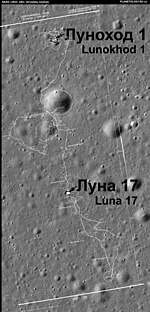Luna 17
 Luna 17 imaged by theLROin 2010 | |||||||||||||||||
| Mission type | Planetary Science | ||||||||||||||||
|---|---|---|---|---|---|---|---|---|---|---|---|---|---|---|---|---|---|
| Operator | Soviet space program | ||||||||||||||||
| COSPAR ID | 1970-095A | ||||||||||||||||
| SATCATno. | 04691 | ||||||||||||||||
| Mission duration | 308 days | ||||||||||||||||
| Spacecraft properties | |||||||||||||||||
| Manufacturer | GSMZ Lavochkin | ||||||||||||||||
| Launch mass | 5,700 kg (12,600 lb)[1] | ||||||||||||||||
| Start of mission | |||||||||||||||||
| Launch date | 14:44:01, 10 November 1970 (UTC)[1] | ||||||||||||||||
| Rocket | Proton 8K82KwithBlok Dupper stage | ||||||||||||||||
| Launch site | Baikonur Cosmodrome | ||||||||||||||||
| End of mission | |||||||||||||||||
| Last contact | 13:05, 14 September 1971 (UTC) | ||||||||||||||||
| Moonorbiter | |||||||||||||||||
| Orbital insertion | 15 November 1970 | ||||||||||||||||
| Moonlander | |||||||||||||||||
| Landing date | 03:46:50, 17 November 1970 | ||||||||||||||||
| Landing site | 38°17′N35°00′W/ 38.28°N 35.0°W[2] | ||||||||||||||||
| Moonrover | |||||||||||||||||
| Spacecraft component | Lunokhod 1 | ||||||||||||||||
| Landing date | 06:28, 17 November 1970 | ||||||||||||||||
| Distance driven | 10.54 km (6.55 mi) | ||||||||||||||||
| |||||||||||||||||
Luna 17(Ye-8 series) was anuncrewed space missionof theLuna program,also calledLunik 17.It deployed the first robotic rover onto the surface of theMoon.
Launch[edit]

Luna 17was launched from an Earth parking orbit towards the Moon and entered lunar orbit on 15 November 1970. The spacecraft softly landed on the Moon in theMare Imbrium(Sea of Rains). The spacecraft had dual ramps by which the payload,Lunokhod 1,descended to the lunar surface.
Lunokhod 1was a lunar vehicle formed of a tub-like compartment with a large convex lid on eight independently powered wheels.Lunokhod 1was equipped with a cone-shaped antenna, a highly directional helical antenna, four telerayspectrometer,anx-ray telescope,cosmic-raydetectors, and a laser retro-reflector (supplied by France[3]) was also included. The vehicle was powered by asolar cellarray mounted on the underside of the lid.
Lunokhod 1was intended to operate through three lunar days but actually operated for eleven lunar days (eleven Earth months). The operations of Lunokhod officially ceased on 4 October 1971, the anniversary ofSputnik 1,after having traveled over 10.5 kilometres (6.5 miles) while taking pictures and performing numerous tests.

Luna 17continued the spate of successes in Soviet lunar exploration begun byLuna 16andZond 8.Luna 17carriedLunokhod 1,the first in a series of robot lunar roving vehicles whose conception had begun in the early 1960s, originally as part of the piloted lunar landing operations. This was the second attempt to land such a vehicle on the Moon after a failure in February 1969.
The descent stage was equipped with two landing ramps for the rover, to disembark onto the Moon's surface.
The 756-kilogram (1,666-pound-11-ounce) rover stood about 1.35 metres (4 feet 5 inches) high and was 2.15 metres (7 feet 1 inch) across. Each of its eight wheels could be controlled independently for two forward and two reverse speeds. Its top speed was about 100 metres per hour (0.062 mph), with commands issued by a five-man team of "drivers" on Earth who had to deal with the 5-second delay. The set of scientific instruments was powered by solar cells (installed on the inside of the hinged top lid of the rover) and chemical batteries.
After two mid-course corrections en route to the Moon,Luna 17entered lunar orbit and then landed on the lunar surface at 03:46:50 UT on 17 November 1970 at 38°17' north latitude and 35° west longitude, about 2,500 kilometres (1,600 miles) from theLuna 16site in theSea of Rains.

The Lunokhod 1 rover rolled over the ramps and onto the lunar surface at 06:28 UT. During its 322 Earth days of operation, the rover traveled 10.54 kilometres (7 miles) and returned more than 20,000 TV images and 206 high-resolution panoramas.
In addition,Lunokhod 1performed twenty-five soil analyses with its RIFMA X-ray fluorescence spectrometer and used its penetrometer at 500 different locations.
Controllers finished the last communications session withLunokhod 1at 13:05 UT on 14 September 1971. Attempts to reestablish contact were finally discontinued on 4 October.
In March 2010, theLunar Reconnaissance Orbiterphotographed the landing site ofLuna 17,showing the lander and tracks of the rover.[4]In April 2010, theApache Point Observatory Lunar Laser-ranging Operationteam announced that with the aid of these photos, they had found the long-lostLunokhod 1rover and had received returns from the laserretroreflector.[5]
See also[edit]
References[edit]
- ^abSiddiqi, Asif (2018).Beyond Earth: A Chronicle of Deep Space Exploration, 1958–2016(PDF)(second ed.). NASA History Program Office.ISBN9781626830431.
- ^"NASA NSSDC Master Catalog - Luna 17/Lunokhod 1".Retrieved2010-12-25.
- ^Leonard David (2013-05-06)."Scientists Bounce Laser Beams Off Old Soviet Moon Rover".Space News.
- ^"Soviet Union Lunar Rovers".Archived fromthe originalon 2014-04-10.Retrieved2020-03-20.
- ^"LOST AND FOUND: SOVIET LUNAR ROVER".
